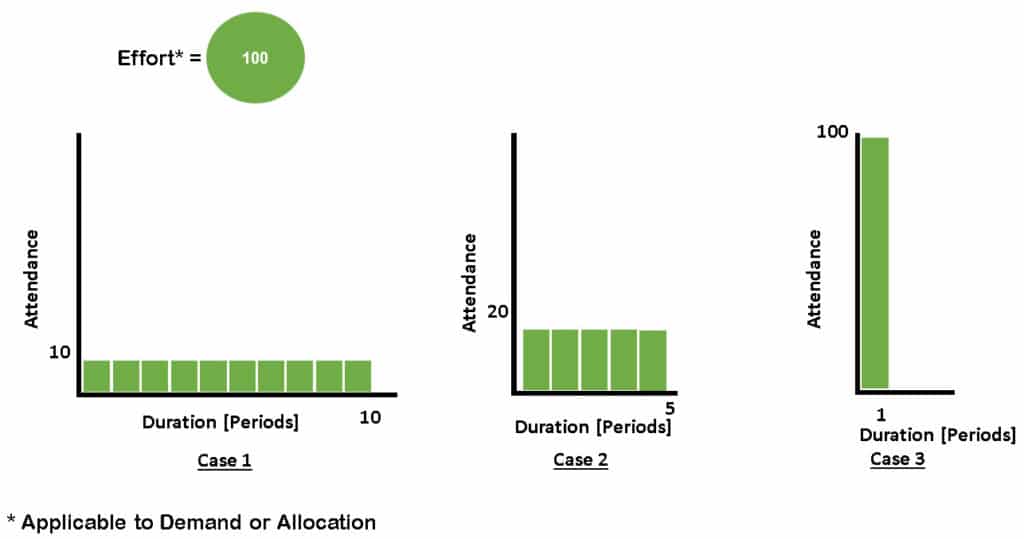Allocate People & Work
Allocate people and work with Resro.ACT’s Resource Allocation function. Use best in class modules to quantify Demand and Allocation; and Effort Management analysis to predict the future. Be certain your projects have the people they need.
Resource Allocation
In any Project Based Enterprise (PBE), the allocation of people to work is a fundamental, challenging and never-ending task of management. But that doesn’t mean that doing it well has to be hard.
On the other hand, the allocation of work to people seems relatively simple. In many workplaces, a Line Manager decides who is best to work on a particular activity or project and then advises the individual verbally. While this might work for a team of 10 or less, it’s not going to work for a team of 100. Alternatively, it might be a Resource Manager who determines the allocation. But no matter whose job it is, Resro.ACT makes it quick and easy to allocate activities to people.
Based on the new theorem of Effort Management, RESRODEL is the powerful way to balance Enterprise Outcomes for people, project delivery and financial performance. By tallying and quantifying the allocation of your people, it reveals compelling insights into your Enterprise’s Drivers for Utilisation and Assignment.
Every PBE’s mission is to ‘apply resources to work to produce outcomes’. The effective assignment of all its people to work leads to optimal utilisation which is then realised in financial performance. But this is not always the case. All too often projects fail to deliver, or people are recruited while others remain idle. RESRODEL solutions alleviate this problem by ensuring that everyone, from across all sub-enterprises, are allocated work before the employment of additional people is considered.
Poorly informed allocation decisions have far reaching consequences for people, projects and enterprise outcomes. RESRODEL solutions provide the decision-ready analytics that will ensure you understand the implications of your decisions before you act on them.
Furthermore, failure to communicate or enable access to Allocation information will also hamper Delivery and Enterprise outcomes. These issues are avoided by RESRODEL solutions as they ensure information is made easily accessible to everyone. At the same time, it empowers and motivates people by enabling them to ‘Accept’ the work that is being allocated to them.
RESRODEL is the ‘resource role model’ with solution that embody the new theorem we call Effort Management. Created specifically for Project Based Enterprises (PBEs), Resro.ACT empowers PBEs to plan people numbers and project work efficiently and take early action for optimal outcomes.
What Is Resource Allocation?
- Process of assigning people to work
- Alternatively known as rostering and scheduling
Who Allocates?
- Resource managers
- Workforce managers
- Workforce analysts
- Line Managers
- Enterprise Managers
- HR
Project Managers do not generally allocate people to work, unless a large project recruits directly, or the Project Manager also Line Management responsibilities.
The problem
- Not understanding what and when Activities are required, and for what specific Roles
- Difficulty finding the right people that are available to fit the Role
- Inability to assess the implications of each allocation to people, projects and financial performance.
- Poor visibility of those partly allocated Activities and the size of the ‘residual’ gap between Demand and Allocation.
- Quantifying people’s allocation into numbers, for analysis, can be tedious
3. Managing change
- Identifying change that inadvertently overwhelms, or reduces an individual’s workload:
- caused by revised timing (usually delay!) or Demand updates
- brought about by changes for the betterment of Activities or Projects, or adjustments to balance Enterprise Drivers for Capability, Utilisation and Assignment
- Difficulty making minor corrections Allocation when a whole person is not required.
- Broadcasting or providing access to Allocation decisions for individuals, Project Managers and Teams
- Reaching consensus, or complying with business rules, particularly when Resource Managers are responsible for proposing people allocation in a cross functional organisation.

The Solutions
- Understand future Activities, Role by Role, or in other ways
- Make faster decisions, focusing on eligible people that fit the Role, and their availability, which include those that might be shared between sub-enterprises
- Check
- The total workload for individual’s
- A project’s ability to deliver
- The PBE’s planned utilisation
- Poor visibility of partly allocated Activities and the size of ‘residual’ gap between Demand and Allocation, so additional Allocation can be arranged.
- Reusing Demand estimates
- Revising estimated Demand to complete estimates
- Changing Duration or Attendance. For example, an Activity requiring 100 days effort, can be done in 10, 5 or 1 days but requires an increasing availability (called Attendance), or visa versa. See Figure 1. Fundamentally, this is ‘resource leveling’, a powerful program (scheduling) process for driving efficiency and performance in PBE’s.
- Quickly checking for individual’s workloads that have inadvertently been overwhelmed, or reduce, (in order of severity) after change
- Easily correcting Allocations by:
- reassigning people
- splitting an Activity among one or more people
- filling any ‘residual’ gaps in allocation
4. Communicate by:
- Enabling easy access to Allocation data for everyone, including individuals, Project Managers and Teams.
- Enabling individuals to ‘Accept’ (or not) the Activities the PBE has allocated them, after they’ve had the opportunity to view time and budget expectations.
- Tracking Allocation status as either ‘Proposed’ or ‘Approved’, to facilitate consensus and business rule compliance.
The provision of information to people, and the act of Accepting work, is very powerful and cannot be underestimated. Individuals with insight into the PBE’s plan for them will be more empowered and motivated because they sense greater control, or influence, and will self-manage better. PBE’s that document and communicate time and budget expectations provide a clarity that can be later used to compare actual performance.
